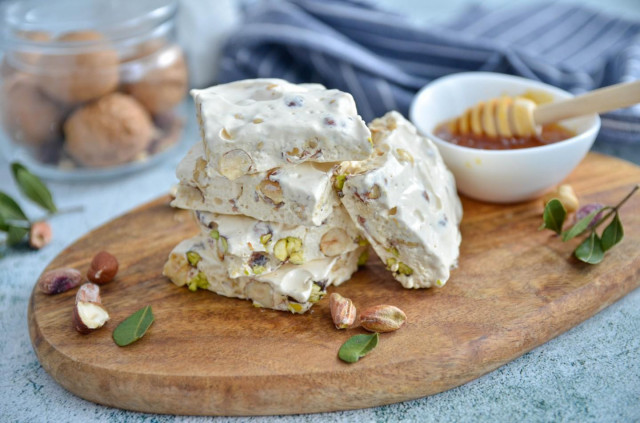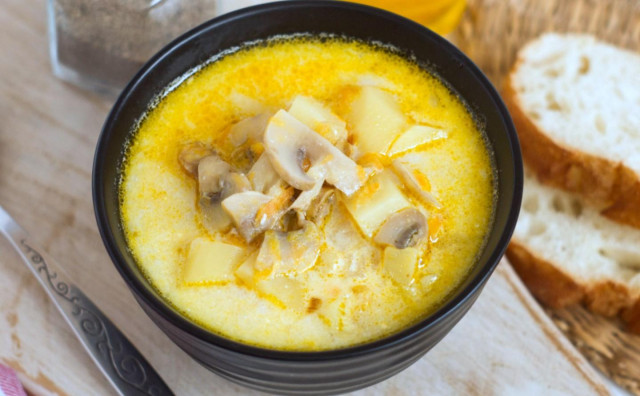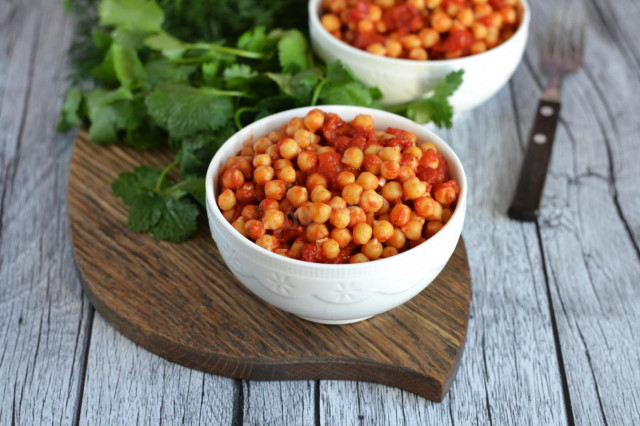Composition / ingredients
Step-by-step cooking
Step 1:
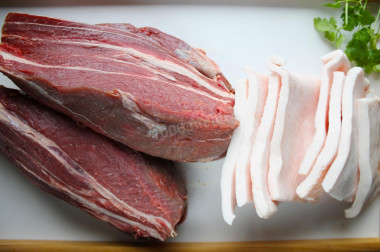
How to make beef sausage at home? What is the best meat to use? Beef pulp is perfect for sausages, choose a fresh piece without bones. Prepare fresh pork fat, with it the finished product will become more juicy and appetizing. Rinse the meat and fat under running water and dry with paper napkins.
Step 2:
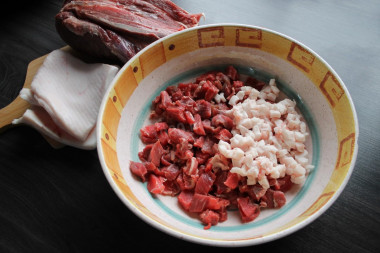
Cut beef into small cubes or plates, remove all veins and films, if any. Chop the fat similarly. To make it easier, send the meat and bacon to the freezer for a while. Frozen foods are cut much easier.
Step 3:
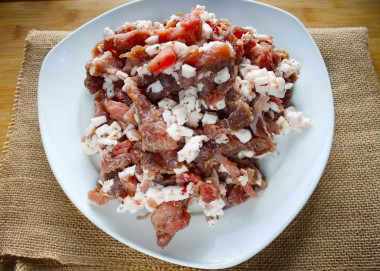
Add spices, salt and sugar to the meat with lard. There is no sugar in the list of ingredients in the original recipe, but I always add a pinch of refined sugar for a more intense taste. Alcohol can also be excluded from the list of components. Sausages will undergo heat treatment, so cognac can not be used. Pick up spices to your taste, use dry seasonings for cooking sausages better, so that the minced meat does not sour while it is in the refrigerator.
Step 4:
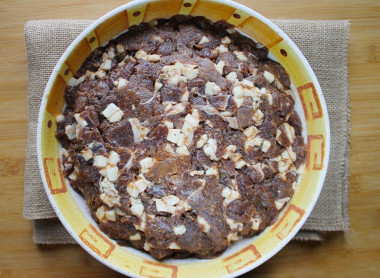
Knead everything thoroughly so that each piece evenly ends up in salt and spices. Cover the cup with plastic wrap or cellophane and send it to the refrigerator overnight or for 6-8 hours. After that, mash the minced meat well again.
Step 5:
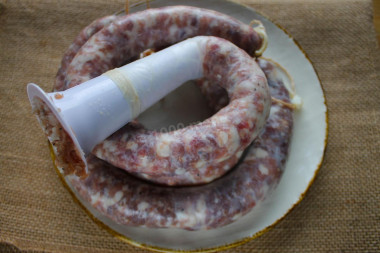
Soak the intestines in cold water for a while, and then rinse again. Their number in the recipe is indicated conditionally, it depends on the diameter of the skull and on how tightly you will stuff the stuffing into the shell. Using a meat grinder and a special nozzle, stuff the minced meat into the intestines. Form sausages or sausages of the desired length. I scrolled half of the minced meat on a smaller grid, and left the second part in large pieces.
Step 6:
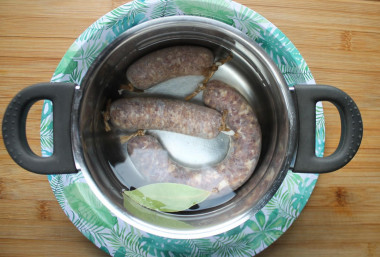
Put the sausages in a saucepan, fill with cold water. For flavor, I added a bay leaf and a quarter of onion to the pan. Put the sausages on the stove when the water is almost boiling, turn down the flame to slightly below average. The water should not boil intensively, but only slightly gurgle.
Step 7:
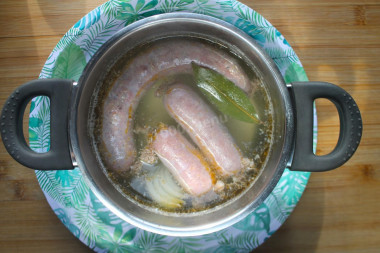
If there is a strong boiling in the pan, then there is a risk that the shell will burst and the minced meat will end up in water. After 5 minutes of low boiling, pierce the intestine with a needle in several places, this will prevent the shell from bursting, since during cooking the sausages increase in volume.
Step 8:
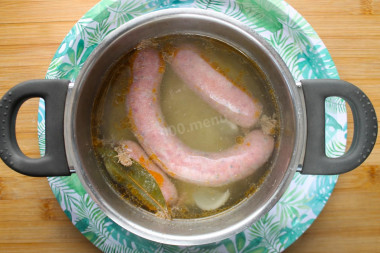
Boil the sausages for 50-60 minutes.
Step 9:
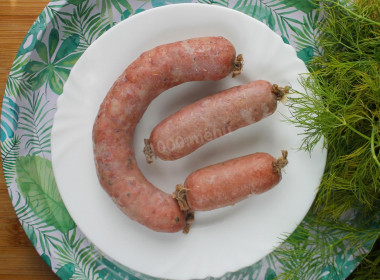
Drain the water, cool the sausage completely. Cut into thin plates and serve!
Step 10:

This is how a sausage looks in a section, the stuffing of which was twisted on a fine grate of a meat grinder.
Step 11:
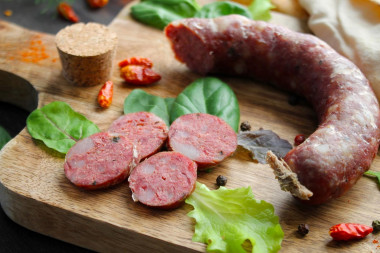
And so the one that was cut by hand.
Stuffing the shell tightly with raw minced meat is not worth it, otherwise there is a risk that the intestine will burst during heat treatment.
Homemade sausage sandwiches are very tasty for breakfast.
Serve the beef sausage on the festive table as a snack.
Bon appetit!
For this recipe, it is better to take fresh meat instead of frozen, otherwise the finished meat risks getting dry.
Since the degree of salinity, sweetness, bitterness, sharpness, acid, burning is individual for everyone, always add spices, spices and seasonings, focusing on your taste! If you put some of the seasonings for the first time, then keep in mind that there are spices that it is especially important not to shift (for example, chili pepper).
If you use ready-made spice mixes, be sure to read the composition on the package. Often, salt is already present in such mixtures, take this into account, otherwise you risk over-salting the dish.
Caloric content of the products possible in the composition of the dish
- Melted beef fat - 871 kcal/100g
- Fat beef - 171 kcal/100g
- Lean beef - 158 kcal/100g
- Beef brisket - 217 kcal/100g
- Beef - okovalok - 380 kcal/100g
- Beef - lean roast - 200 kcal/100g
- Beef shoulder - 137 kcal/100g
- Beef - ribs - 233 kcal/100g
- Beef - ham - 104 kcal/100g
- Beef - tail - 184 kcal/100g
- Boiled ham - 269 kcal/100g
- Beef corned beef - 216 kcal/100g
- Pork fat - 871 kcal/100g
- Melted pork fat - 947 kcal/100g
- Pork rinds - 895 kcal/100g
- Lard - 797 kcal/100g
- Spy - 658 kcal/100g
- Granulated sugar - 398 kcal/100g
- Sugar - 398 kcal/100g
- Ordinary cognac "three stars" - 239 kcal/100g
- Cognac - 239 kcal/100g
- Salt - 0 kcal/100g
- Pepper - 26 kcal/100g
- Garlic powder - 331 kcal/100g
- Pork intestines - 602 kcal/100g
- Nutmeg - 556 kcal/100g





